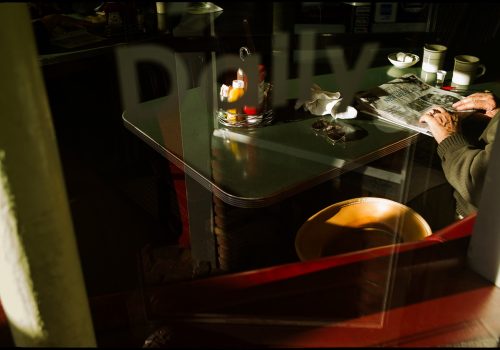Mark Berndt is a photographer long fascinated by the quotidian. His pictures, which portray the incidental intersection of light, color and shape, are evocative and emotional. His new show The Simple Arrangement of Things, currently running at Edition One gallery in Santa Fe, NM is comprised of 28 prints in various sizes, all beautifully made. Somewhat startling, they are unframed, the pristine surfaces directly exposed to the viewers gaze but also to dirt, smoke and the fingers of the curious. Given the impracticality of this as a long term display method I sat down with Mark to ask him why he had chosen to show the pictures this way and to talk about his thoughts on seeing images on the screen versus the print.
You have some strong views about when your work is finished. Could you talk about the importance of experiencing the print?
For me, the photograph is only finished when you have a thing to hold in your hands. For this show, I wanted the prints to be immediately available, a tactile experience for the viewer, I wanted people to see the images bigger than they see them looking at a phone screen or on a laptop and I wanted them to experience the surface of the image directly, without first going through some barrier.
And what about silver versus inkjet printing?
I began to understand that difference back to 1995 when I first started doing digital printing and realized that digital prints are photographs but they are also works on paper. They are not a chemical process and fundamentally different from silver gelatin dipped in trays. Nowadays I don’t consider them photographic prints as much as ink on paper and at this point they far surpass what we could ever achieve in the darkroom…
…One of the big things about digital printmaking today is the options we have in paper. Paper contributes a lot to the experience of the print and different types of images work better on different types of paper. Although I have long been printing on matte papers, for this show I chose a luster because it seemed to have a larger gamut and the ink didn’t wick into the fibers as much, it sits on the surface a little bit more. The sheen of the luster paper also adds to the physical plane of the image and the sum of everything adds a three-dimensional quality that I don’t experience with matte papers as much.
And the experience of printing, how has that changed for you?
Digital printers are robots, it’s about what you give them to print, about taking care in the preparation of the file to get everything out of it rather than orchestrating the final appearance of the image at the moment of printing as we did in the analog days. I love the taking of the image but I also love this new post production process and this way of making something you can hold in your hands.
Tell us about showing the prints unframed. Why are you doing that?
As to long term display, the reality is that the frame is the archival box, the container for a piece of art. It’s a thing to help the print last as long as it possibly can. So no, this is not the way to display these pictures over time. The gallery is a parlor of experience. I wanted people to experience what they will be putting in the box. I wanted them to have the opportunity to see the print up close, to look at it at an angle and examine the surface, perhaps to feel the paper in their hands. Then they can spend whatever they like making a box to preserve that experience…
One of the things about seeing the print directly the first time you look at it is that the physical experience becomes part of the memory. As an owner looks at their picture over time, in addition to what they have taken from the image emotionally they will remember the physical part, that experience also lingers.
Your final thoughts about the importance of the print?
For me it’s important to have a box of prints, to be able to take them out and study them. It’s like they are finalized then. On a screen the image is never finalized, it’s not even really there. The whole time you’re looking at an image on a screen it’s there…not there… there… When it’s a print it’s done, it’s cooked, it’s complete.
Interview by Andy Romanoff
Andy Romanoff is a photographer and writer based in Los Angeles, USA.
Mark Berndt – The Simple Arrangement of Things
April 6th through May 25th
Edition One Gallery
728 Canyon Rd
Santa Fe, NM 87501
USA
https://www.editionone.gallery/
Writing https://medium.com/stories-ive-been-meaning-to-tell-you
Photography http://andyromanoff.zenfolio.com/
















